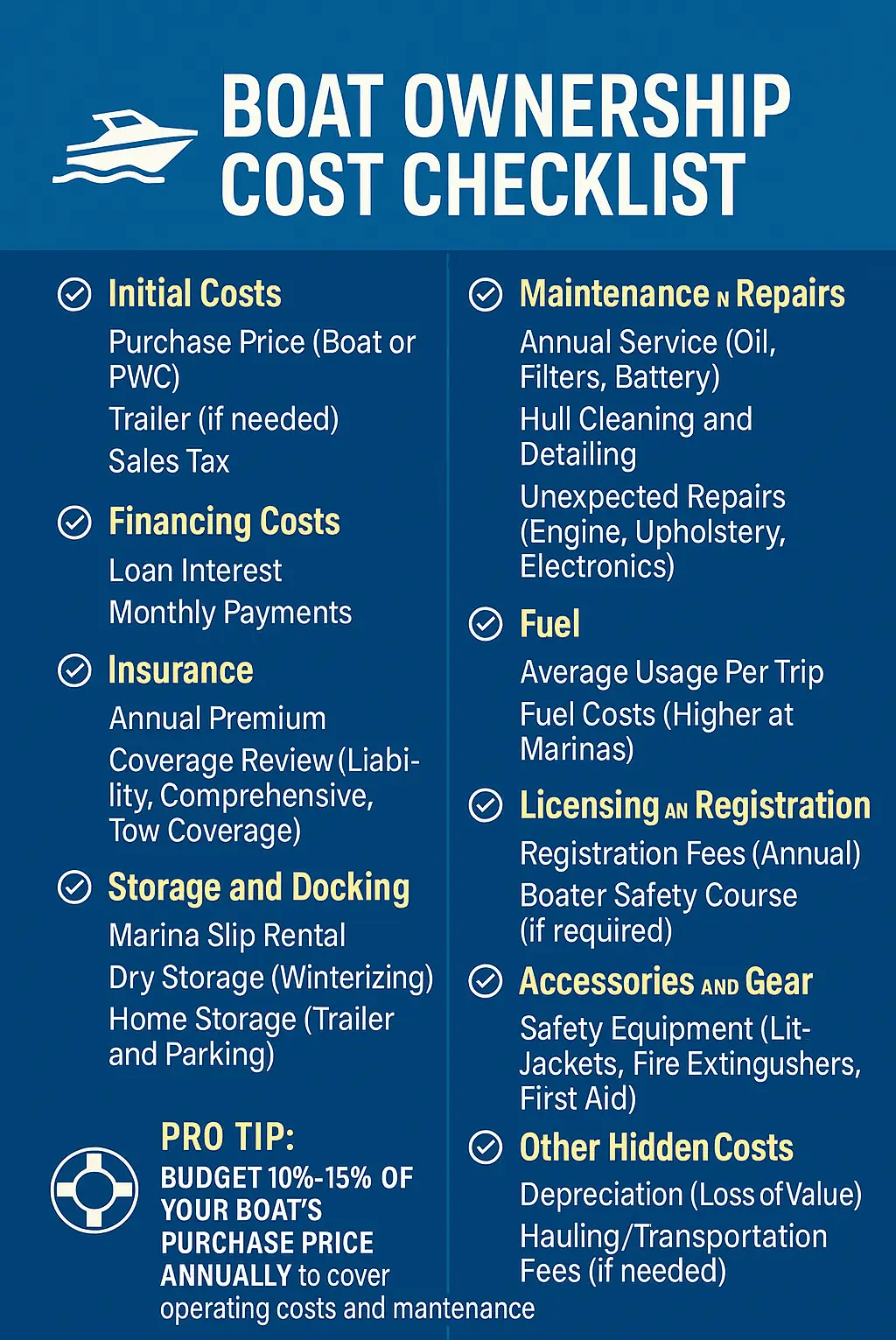- 12741 Research Blvd. Suite 500 Austin, TX
- sales@rastracmarinevision.com
- (877) 680-1188
For many, the dream of sunny days on the water — whether cruising in a pontoon, carving wakes behind a ski boat, or zipping around on a jet ski — is too tempting to resist. However, while the purchase price gets most of the attention, the total cost of ownership (TCO) can surprise even seasoned boaters. Understanding all the expenses involved can help you budget better and enjoy your watercraft without financial stress.
Here’s a detailed look at what goes into the real cost of owning a boat or personal watercraft (PWC).
The starting point is, of course, the initial cost:
Ski/Wake Boats: $75,000–$200,000+ (high-end models can top $300,000)
Pontoon Boats: $30,000–$120,000 depending on size, motor, and luxury features
Jet Skis/PWCs: $8,000–$20,000
New boats come with warranties and fewer hidden issues, but used boats can save substantial upfront cash — though possibly at the expense of immediate repairs and updates.
Most boat buyers finance their purchase, and interest can add significantly over the life of the loan. For example:
A $100,000 boat at 7% interest over 10 years results in nearly $40,000 in interest payments.
Longer terms (sometimes up to 20 years) lower monthly payments but increase total costs.
Boat insurance is essential and, in some places, required. Rates vary based on:
Boat value
Type of boat
Location (hurricane-prone areas cost more)
Owner’s boating history
Typical annual insurance costs:
Ski/Wake Boat: $800–$2,000
Pontoon Boat: $300–$800
Jet Ski: $150–$500
Liability-only policies are cheaper but leave you exposed if you have a major loss.
Unless you live on waterfront property, you’ll need somewhere to keep the boat:
Dry storage (winterizing): $500–$2,500+ per season
Marina slip rental: $2,000–$7,000+ per year depending on location
Trailer purchase (for home storage): $1,500–$8,000
Remember to budget for transportation costs if you’re hauling your boat.
Annual maintenance is a must to prevent larger (and much more expensive) problems later:
Oil changes, filters, winterizing: $300–$1,000 per year
Cleaning and detailing: $200–$600 per service
Unexpected repairs (engines, electronics, upholstery): Varies wildly; a new engine can cost $10,000–$25,000.
Even a brand-new boat can have warranty repairs or unexpected issues — and these aren’t always fully covered.
Boats aren’t known for fuel efficiency:
Ski and wake boats often burn 8–15 gallons per hour.
Pontoon boats are better but still guzzle fuel under heavy loads.
Jet Skis can burn 4–10 gallons per hour depending on how aggressively you ride.
Fuel dock prices also tend to be higher than roadside gas stations, sometimes by $1–$2 more per gallon.
Every state requires registration, and many charge sales tax on boat purchases:
Registration fees: $25–$300 annually
Sales tax: 4%–10% depending on your state
Luxury taxes (on very expensive models) may apply in certain areas.
New owners often underestimate how many “extras” they’ll want or need:
Safety equipment (life vests, fire extinguishers, flares): $500–$1,500
Wakeboards, tubes, ropes, skis: $100–$2,000+
Upgraded stereo systems, depth finders, lighting: $500–$10,000
These are not mandatory, but they greatly enhance the fun and safety factor.
Boats depreciate quickly — often faster than cars. Expect:
15%–25% value drop in the first year
40%–60% over five years
High-end wake boats and pontoons sometimes hold value better if meticulously maintained, but depreciation is inevitable.
Here’s a rough annual estimate for typical ownership costs (excluding purchase price):
| Watercraft Type | Annual Cost Estimate |
|---|---|
| Ski/Wake Boat | $8,000–$20,000 |
| Pontoon Boat | $4,000–$10,000 |
| Jet Ski | $1,500–$3,500 |
Actual costs depend heavily on use, location, and whether you pay for storage, maintenance, and repairs versus DIY.
✅ Real-Time GPS Tracking: Instantly locate your boat or PWC, reducing the risk of theft and loss. Some insurance companies even offer discounts for GPS-tracked vessels.
✅ Prevent Unauthorized Use: Get alerts if your boat moves outside of set zones or hours, helping prevent damage or misuse when stored at marinas or docks.
✅ Maintenance Monitoring: Rastrac’s tracking technology can log engine hours and movement, helping you stay on top of maintenance schedules and avoiding expensive repairs.
✅ Optimize Fuel Use: Track trip histories and travel patterns to plan more efficient routes and save fuel over time.
✅ Asset Management: For owners of multiple boats or rental fleets, Rastrac gives a clear overview of all vessels, minimizing downtime and maximizing asset lifespan.
✅ Peace of Mind: Know where your investment is at all times — whether you’re away for the weekend or winterizing for the season.


Rastrac complements any organization-wide quality assurance program and can help their fleet become the model for operational superiority.
Rastrac helps clients make improvements in processes, organization, financials, communications, and technology. Clients that have taken advantage of Rastrac’s ability to provide solutions tailored to their business are in a wide variety of industries. Rastrac can help you find a solution, too.
We’d love to discuss how we can help you.







